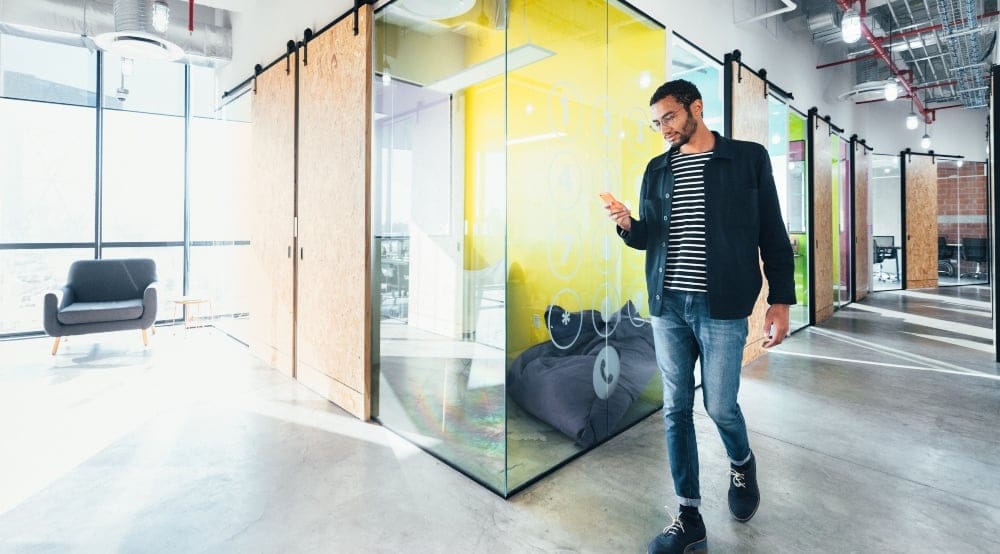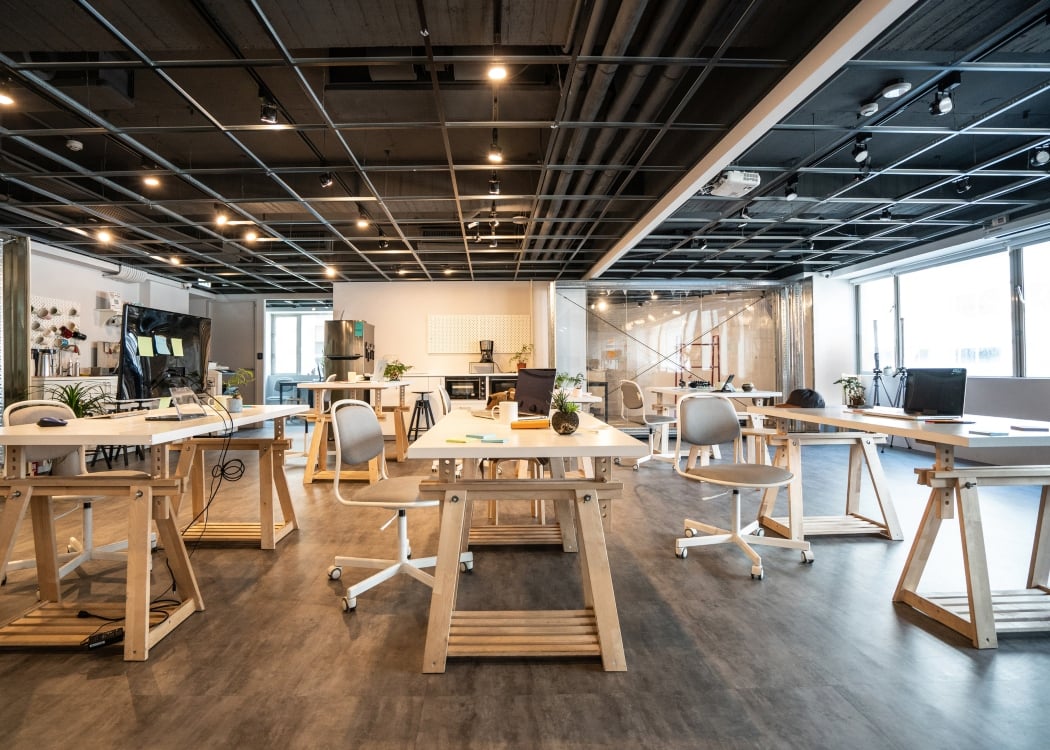
Let us help you with finding an office space
Our experts are here to help take the hard work out of finding your next office space.

As the UK’s vaccine rollout signals a light at the end of the tunnel, businesses are looking to the future. Those planning to hit the ground running will be organising their workplace strategies now for the new world of work. To help you get the balance right for your business, here’s a checklist of things to consider.
First and foremost, it’s important to remember that flexibility will play a pivotal part in workplace strategies moving forward. That might involve creating a flexible working policy, leasing flexible office space, or offering a range of working environments to your employees.
Choice will be paramount, and so too will support. The upheaval of Covid-19 is likely to inspire a new relationship where employees look to their employers to help with new priorities, such as health and wellbeing.
The right office space strategy can help lay the foundation for these shifts. So, where do you begin? And what do you need to consider in a post-Covid world of work? We dive into the types of spaces you should consider, who should come back to the office, when you should start searching, where you should base your business and how you can achieve all of the above.
As Amanda Lim explains in our article, 6 Things UK Businesses Want From a Post-Covid Office: “There is a growing need for businesses to provide space for their employees to share ideas, collaborate and learn together. The quantum of space, and mix of spaces required by businesses – core, flex, and home – is not a ‘one size fits all’ model.”
In terms of the type of office space you can opt for, your options are wide and varied; you no longer have to commit to a minimum three-year lease, you choose an all-inclusive, monthly-rolling contract thanks to flexible office space. But the route you take will depend on your requirements.
For example, you’ll need to bear in mind the certainty of your current and future headcount. Flexible offices are easy to downsize in, but traditional office space is little trickier to scale-back. Likewise, remember that serviced office space is always ready to move straight into, but you’ll have to furnish the office yourself with a traditional lease.
Get your monthly dose of workplace insights, productivity hacks and business leadership ideas - delivered straight to your inbox.
 Within your office, it’s worth thinking about the types of environments you need. After months of working from home, the role of the office is likely to become more geared towards collaboration, innovation and employee development.
Within your office, it’s worth thinking about the types of environments you need. After months of working from home, the role of the office is likely to become more geared towards collaboration, innovation and employee development.
Our infographic, Which Type of Office Should I Rent? will help steer you in the right direction between serviced office space, managed office space and traditional office space. And of course, your workplace strategy can involve a strategic blend of these. Some large corporates, for example, choose to sign up for traditional office space, and use flexible office space as needed for overflow or project space.
Likewise, within your office, it’s worth thinking about the types of environments you need. After months of working from home, the role of the office is likely to become more geared towards collaboration, innovation and employee development. In fact, 53% of UK businesses surveyed by Knight Frank said they wanted their offices to have a greater amount of collaboration space.
Naturally, rigid desk set-ups aren’t the most fruitful spaces for this to take place. That’s why some companies are looking to reduce the amount of traditional desk space they have, and replacing it with more agile environments that both inspire collaboration and break up a sedentary day – from quiet breakout spaces to on-your-feet brainstorming spaces. This variety will also help provide different roles with the right environments to work effectively – phone booths, for example, could replicate the quiet solitude of remote working for those who need it.
It’s also worth thinking about the amenities you want to offer your teams. As working from home is proving to be a useful stand-in for some, a shift back to the office will involve incentivising employees to invest (emotionally and financially) in a commute.
Perks like help-yourself-pantries, events calendars, ergonomic furniture, breakout spaces, wellbeing initiatives, training and development opportunities and trendy private offices are bound to help create that all-important ‘office experience’. It’s unsurprising that 63% of UK businesses are anticipating a greater focus on the design and specification of their future offices.
 Perfecting a sales or a business development role is often hinged upon overhearing conversations, learning by osmosis and being engrained into a company’s workstreams. That’s unlikely to effectively happen from behind a screen in a living room.
Perfecting a sales or a business development role is often hinged upon overhearing conversations, learning by osmosis and being engrained into a company’s workstreams. That’s unlikely to effectively happen from behind a screen in a living room.
When figuring out who needs to return to the office and when, you’ll primarily want to consider which roles are better suited to which environment (office vs. the home). For leaders and managers, growing a successful team (in terms of motivating employees, developing skillsets and even onboarding new talent) is almost impossible to successfully do in a remote-only environment.
Likewise, perfecting a sales or a business development role is often hinged upon overhearing conversations, learning by osmosis and being engrained into a company’s workstreams. That’s unlikely to effectively happen from behind a screen in a living room. But on the other hand, writers and creatives might thrive in the quiet solitude of remote working.
Meanwhile, jobs which involve handling sensitive data might be better protected by enterprise-grade internet connections and the controlled environment of an office.
Team rotas can help ensure those working closely can meet on the same day, and if you’re worried about your budget, team-specific days might also enable you to downsize your space. However, relying solely on team-specific schedules might isolate departments from company-wide knowledge, cross-team collaborations and chance encounters with others – all of which are essential to innovation.
Personal preference should also play a part in determining who should come back to the office – especially considering employee autonomy is crucial to productivity.
Everyone’s working from home experience has been different. A 26-year-old employee working from a crowded flatshare in London might be craving ergonomic furniture and physical work-life separation. But a 45-year-old solo worker with a home office an hour’s commute away from your HQ might feel more inclined to spend four days a week at home.
Likewise, the task at hand will have a part to play. If teams are in planning mode, a day full of brainstorms and strategy meetings is better placed in a face to face environment, rather than on a potentially temperamental video call – which is difficult for introverts and minorities to contribute to.
In theory, everyone should come back to the office – even if to occasionally touch base, rebuild social capital, feel seen and feel connected to the bigger picture. But the frequency of that will need to be determined on a case by case basis. It’s worth engaging in open, honest and business-wide conversations about personal preferences, common goals and worries.
 Some companies are looking to reduce the amount of traditional desk space they have, and replacing it with more agile environments that both inspire collaboration and break up a sedentary day – from quiet breakout spaces to on-your-feet brainstorming spaces.
Some companies are looking to reduce the amount of traditional desk space they have, and replacing it with more agile environments that both inspire collaboration and break up a sedentary day – from quiet breakout spaces to on-your-feet brainstorming spaces.
In the world of flexible office space, many providers are offering delayed start dates which allow you to commit to office space now and move in four to five months down the line.

In the world of flexible office space, many providers are offering delayed start dates which allow you to commit to office space now and move in four to five months down the line. Some have even said they’ll accommodate start dates up to six months later for the right business and the right sized office.
Plus, starting your office search now will help you take advantage of any discounts on offer – providers know that budget is a concern for some businesses right now. It’s worth getting in touch to find the best deal.
And though this varies on a case by case basis, some providers are still including ‘Covid-19 clauses’ in contracts, which state that in the event of another lockdown, rents will be reduced so businesses don’t have to pay full price for space they can’t use.
Though signing up for a flexible office space can have you moved in within a matter of days, moving into a traditional office space takes a lot longer. For that reason, if traditional is the right route for you, you’ll still want to start your search now. You can view our Flexible Office Space vs. Traditional Office Space comparison to help you decide.
 As sustainability climbs the corporate agenda, you could look to encourage a greener commute, perhaps by finding an office that accommodates a cycle-to-work scheme with its proximity to cycleways, and of course, offers secure bike racks, showers and lockers.
As sustainability climbs the corporate agenda, you could look to encourage a greener commute, perhaps by finding an office that accommodates a cycle-to-work scheme with its proximity to cycleways, and of course, offers secure bike racks, showers and lockers.
There’s no doubt that Covid-19 has invited many businesses to question the nature of their office space strategies. On a macro-scale, some businesses might even choose to rethink their global footprint.
Writing in our 12 Dynamics of the Post-Covid Workplace, Lee Elliott, Global Head of Occupier Research explains: “Covid-19 has shown that both manufacturing and service companies are too dependent on thin supply chains and often a single country. We expect to see more business activities nearshored or onshored, and/or the greater distribution of activity to reduce geographical dependency.”
On a more local scale, some businesses might reassess whether a regional base is better suited than a London HQ, and vice versa – or even a combination of the two with a hub and spoke model, which is speculated to gain traction. Or, where you base your business might vary from department to department, with some functions (perhaps those that aren’t client-facing and can ‘work from anywhere’) better placed in more cost-effective locations.
Meanwhile, the appeal of a shorter commute and the desire to avoid public transport are also inspiring some businesses to look for multi-site access to offices in a range of locations.
With flexible office space, this is available most of the time; you’re signing a lease with the provider, rather than with the building. So, while you’ll always have your private office as a set base, some brands will grant you multi-site access to breakout areas in their other buildings (though this is decided on a case by case basis, so get in touch with us to discuss your options).
If you’re considering relocating within the same city, transport might be a prime factor to consider. You might look at helping your teams work closer to home, for example, by relocating to transport hubs with mainline train services such as Victoria or Waterloo to minimise tube travel.
Or, as sustainability climbs the corporate agenda, you could look to encourage a greener commute, perhaps by finding an office that accommodates a cycle-to-work scheme with its proximity to cycleways, and of course, offers secure bike racks, showers and lockers. This could be a solution for those wanting to reduce the amount of time spent on public transport, too.
 On a more local scale, some businesses might reassess whether a regional base is better suited than a London HQ, and vice versa – or even a combination of the two with a hub and spoke model, which is speculated to gain traction.
On a more local scale, some businesses might reassess whether a regional base is better suited than a London HQ, and vice versa – or even a combination of the two with a hub and spoke model, which is speculated to gain traction.
Speaking to one of our experts is a great place to start. Our Flexible Office Solutions team is here to help, and even if flex space isn’t the right fit for you, we’ll refer you to the right team.
As we explore in our blog, The Easiest Way to Rent Serviced Office Space in London, you could go directly to a flexible office space provider and sign at a similar speed, but a team of unbiased experts will genuinely work to find the right fit for you, consult you on your options and guide you through the entire process – alleviating all the hassle (like booking viewings and arranging tours).

Our experts are here to help take the hard work out of finding your next office space.